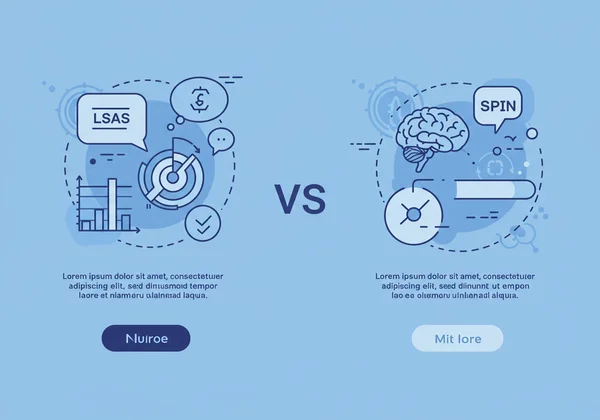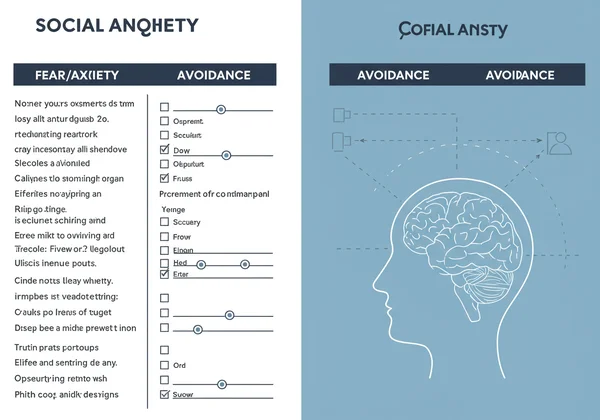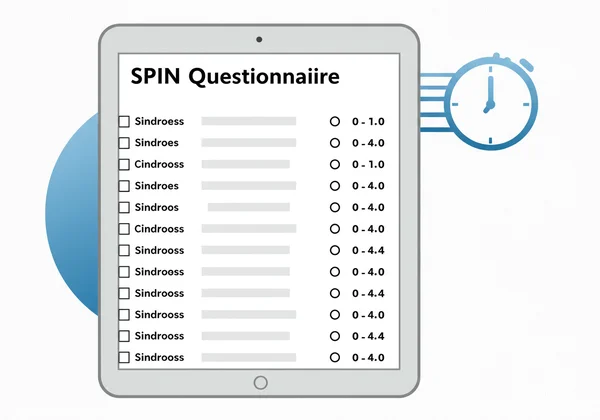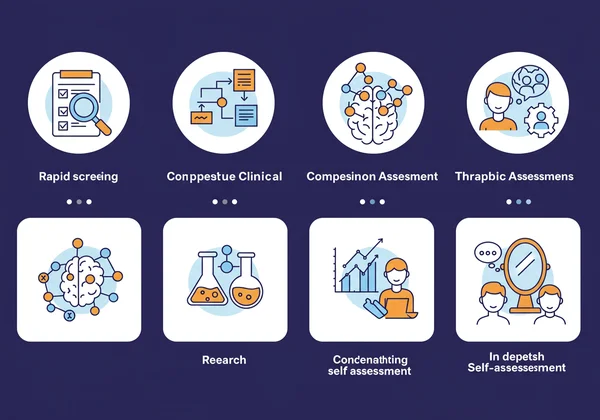LSAS 与 SPIN:社交焦虑量表专业指南
进行心理评估可能很复杂,尤其是在评估社交焦虑等状况时。对于临床医生、研究人员和学生来说,选择正确的工具对于准确测量和有效干预至关重要。该领域最常用的两个工具是莱博维茨社交焦虑量表 (LSAS) 和社交恐惧症量表 (SPIN)。但是,如何根据您的具体需求在 LSAS 与 SPIN 之间做出选择呢?这份专业指南提供了详细的比较,以帮助您做出知情的决定。
对这些工具的理解是清晰认识社交焦虑的第一步。无论是用于临床评估、研究,还是更深入的个人理解,这项分析都将阐明每种量表的独特优势和应用。对于那些希望亲身体验全面评估的人,您可以在我们的平台上 探索 LSAS。

探索莱博维茨社交焦虑量表 (LSAS)
莱博维茨社交焦虑量表被广泛认为是评估社交焦虑的黄金标准。它由精神病学家兼研究员迈克尔·R·莱博维茨博士开发,提供对社交情境如何影响个体的细致入微和全面评估。
什么是莱博维茨社交焦虑量表?
这份问卷是一个包含 24 个项目的工具,旨在衡量社交焦虑的完整范围。它独特地评估两个关键维度:在各种社交和表演情境中体验到的恐惧或焦虑程度,以及对这些情境的回避程度。这种双重关注提供了比那些只测量恐惧的量表更全面的视角,因为回避是社交焦虑症的一个关键行为组成部分。该量表涵盖了广泛的情境,从公开演讲到闲聊。
量表的结构、评分和解读
量表中的每个 24 个项目都进行两次评分。首先,根据恐惧程度在 4 分制量表(0-3)上评分;其次,根据回避频率在 4 分制量表(0-3)上评分。这会得出两个不同的子分数——一个用于恐惧,一个用于回避——它们相加得出总分,范围从 0 到 144。
通常,此评估的分数解读如下:
- 55-65: 中度社交焦虑
- 65-80: 明显社交焦虑
- 80-95: 重度社交焦虑
- >95: 极重度社交焦虑
这种详细的评分系统对于追踪治疗进展和了解个人焦虑的具体动态至关重要。您可以在我们的网站上获得自动即时的 LSAS 分数含义。

量表的临床应用
由于其强大的心理测量学特性和对变化的敏感性,这个社交焦虑量表在临床研究和实践中被广泛使用。它经常用于临床试验,以衡量社交焦虑症治疗的疗效。临床医生将其用于初步评估、治疗计划和监测患者随时间推移的进展。其全面性有助于专业人员识别可在治疗中针对的特定情境触发因素。
深入了解社交恐惧症量表 (SPIN)
社交恐惧症量表(SPIN)是另一个广泛使用的社交焦虑自我报告测量工具。它由乔纳森·R·T·戴维森博士开发,提供了一种快速而有效的社交恐惧症筛查方法。
了解 SPIN 问卷
SPIN 是一个包含 17 个项目的问卷,要求个体评估在过去一周中某些情境困扰他们的程度。与 LSAS 不同,LSAS 将恐惧和回避分开,而 SPIN 将三个关键领域整合到其问题中:恐惧、回避和生理症状(如脸红或心悸)。这使其成为一个简洁的工具,能够快速了解社交焦虑体验。
SPIN 评分及其在评估中的应用
受访者在 5 分制量表(0-4)上对每个 17 个项目进行评分,从“完全没有”到“极其严重”。总分范围为 0 到 68。19 分或更高的分数常被用作临床分界点,表明社交焦虑可能是一个值得进一步评估的重大问题。由于其简洁性和简单的评分方式,SPIN 是在初级保健环境或大规模研究中进行快速筛查的绝佳工具。

LSAS 与 SPIN:社交焦虑量表的比较分析
尽管莱博维茨社交焦虑量表和 SPIN 都是经过验证且可靠的工具,但它们的设计初衷不同。了解它们的区别对于根据您的目的选择合适的 社交焦虑量表 至关重要。
结构和侧重点的主要差异
最主要的区别在于它们的结构。莱博维茨量表包含 24 个项目,并采用恐惧和回避的双重评分系统,提供了细致入微、多维度的视角。SPIN 的 17 个项目提供了更综合的评估,包括生理症状。这个工具在区分恐惧的认知体验和回避的行为反应方面更出色,这对于详细的 社交焦虑的临床评估 至关重要。为了清晰演示,您可以 试用我们的免费工具。
心理测量学特性:信度和效度
两种量表都表现出强大的信度和效度。然而,莱博维茨评估由于其对治疗效果的敏感性,在研究环境中常被优先选择。其详细的结构允许研究人员独立测量恐惧和回避行为的具体变化。SPIN 的优势在于其作为筛查工具的诊断准确性高,能有效识别可能符合社交焦虑症标准的个体。
最佳应用场景:临床评估、研究和自我筛查
在两种量表之间做出选择完全取决于具体情境。
-
用于快速筛查: SPIN 是理想选择。其简洁性使其非常适合繁忙的临床环境或希望快速检查的个人。
-
用于全面临床评估: 莱博维茨社交焦虑量表更胜一筹。它提供了进行彻底诊断评估和有针对性治疗计划所需的深度。
-
用于研究: 该量表通常是首选工具,特别是在衡量治疗效果的研究中,因为它具有详细的子量表。
-
用于深入自我评估: 像莱博维茨量表这样的工具提供了更全面、更具教育意义的体验,帮助个人了解他们的特定触发因素。我们的 在线 LSAS 测试 就是为此目的而设计的。

为什么我们的平台是社交焦虑评估的可靠资源
在寻求在线评估时,可靠性和深度至关重要。我们的平台致力于提供一个不仅易于访问,而且科学严谨、见解深刻的工具,使其成为任何对 莱博维茨社交焦虑量表 感兴趣的人的首要资源。
我们在线评估的准确性和可访问性
我们的平台提供完整的 24 项莱博维茨社交焦虑量表,确保您获得基于原始、经过验证量表的全面而准确的评估。我们使整个过程变得简单直接且用户友好,以超过 15 种语言免费提供测试。这种对可访问性的承诺确保了任何人,无论身在何处,都能更好地了解他们在社交场合的自在程度。您只需点击几下即可 开始您的评估。
超越分数:AI 驱动的深度理解洞察
分数只是一个数字。真正的理解源于情境。这就是为什么我们提供独特的、可选的 AI 驱动分析,它超越了标准报告。这份个性化报告帮助您识别您的特定社交触发因素,突出个人优势和挑战,并提供切实可行的改进建议。它将您的测试结果从一个简单的数据点转化为自我反思和改进的路线图,这一功能对个人和专业人士都非常宝贵。探索 AI 洞察 了解更多。
选择正确的社交焦虑评估工具
在 LSAS 与 SPIN 的比较中,没有绝对的赢家——只有适合特定任务的正确工具。SPIN 作为快速有效的筛查工具表现出色,而莱博维茨量表则作为全面、细致评估的黄金标准脱颖而出。对于寻求对社交焦虑有深入且能够指导行动的理解的专业人士、学生和自我探索者,莱博维茨社交焦虑量表的详细框架是无与伦比的。
我们邀请您体验一次专业评估所能提供的清晰度和深度。今天就通过探索我们免费、保密且有科学依据的 社交焦虑自我评估,进一步了解社交焦虑。
常见问题解答
什么是莱博维茨社交焦虑量表 (LSAS)?
它是由迈克尔·莱博维茨博士创建的 24 项问卷,用于测量各种社交和需要表现的情境中的恐惧和回避。它被认为是详细评估社交焦虑的“黄金标准”。
在临床环境中如何解读该量表的分数?
分数被归类为不同的严重程度,例如中度 (55-65)、明显 (65-80)、重度 (80-95) 和极重度 (>95)。临床医生使用这些分数来衡量社交焦虑的强度并追踪治疗期间的变化。我们的平台在您完成测试后提供 即时分数解读。
两种量表的主要区别是什么?
主要区别在于结构和侧重点。莱博维茨量表(24 项)分别测量恐惧和回避,提供更详细的分析。SPIN(17 项)是一个更快的筛查工具,它将恐惧、回避和生理症状结合成一个单一分数。
哪种社交焦虑量表更适合自我评估而非专业诊断?
对于快速自我筛查,SPIN 是理想选择。对于可以为与专业人士的对话提供信息的更全面的自我评估,莱博维茨量表是理想选择。请注意,任何在线测试都不能提供医学诊断;结果应始终与合格的医疗保健提供者讨论。我们的 免费 LSAS 测试 是自我探索的绝佳起点。